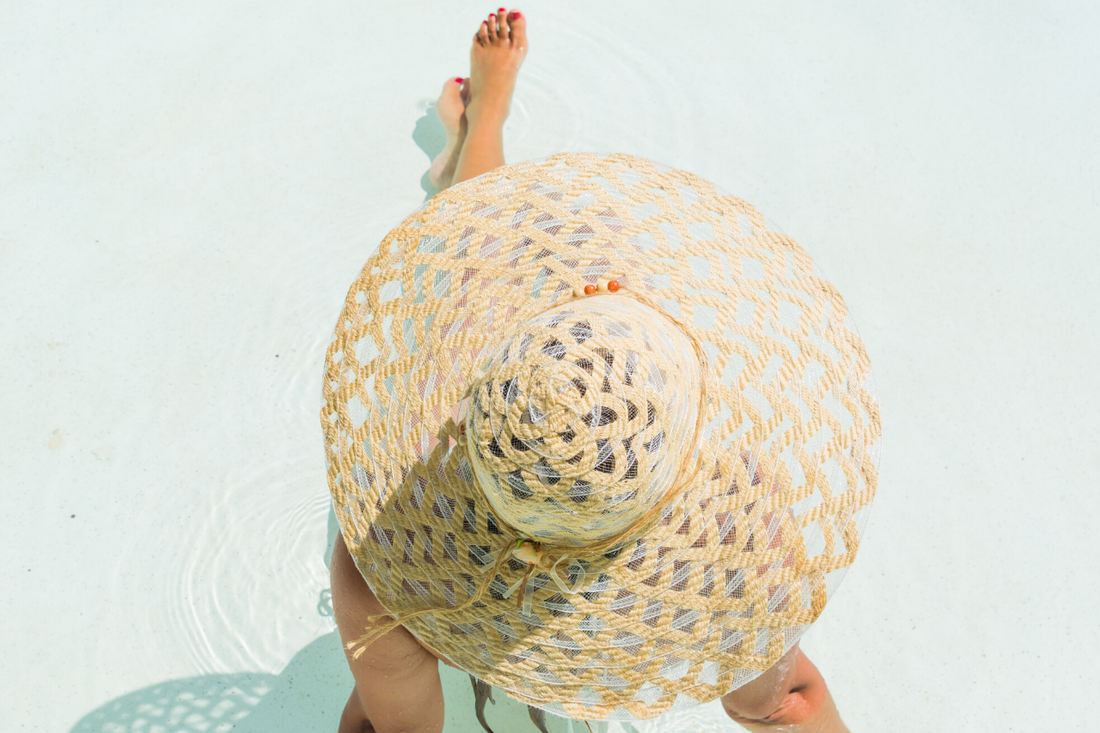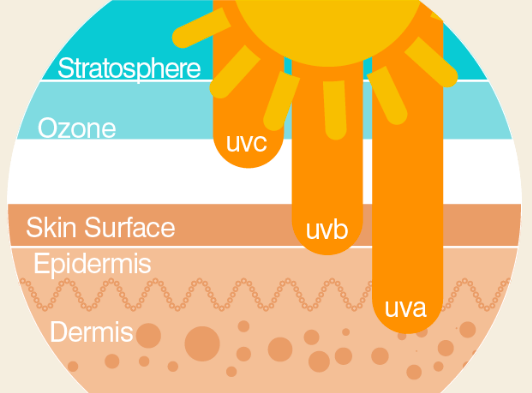Blog
This Is How to Avoid Sun Damaged Skin Every Summer
Want to avoid sun damaged skin this, and every, summer? Learn how in this post! SHOP RADIANT SKIN SET Also known as premature aging or photoaging, sun damage refers to skin that’s been wrecked by exposure to the sun’s harmful ultraviolet (UV rays). There are ways to prevent, and to repair, some of this damage. Read on for more information. Every time you go outside or sit by a window without sun protection, or use a tanning bed, you’re putting yourself at risk for skin damage. Over time, this damage can build up, leading to skin changes making you look years older than you normally would. Changes include: Wrinkles and fine lines Age spots and other pigmentation Loose skin Spider veins Blotchy or ruddy complexion Tanning beds can cause these changes to occur very quickly, sometimes in as little as a year! The damage can lead to deeper lines or dry, scaly patches – actinic keratoses (AKs), pre-cancerous skin growth, which can lead to skin cancer. You Can Protect Against Sun Damaged Skin. Reverse It Also Radiant Skin Set The best way to decrease your chances of sun damaged skin is to protect yourself from the sun’s UV rays. Don’t sit out with unprotected skin – wear long sleeves and put on sunglasses Seek shade wherever possible Minimize sun exposure when UV rays are strongest, between 10 am and 4 pm. Use a well-formulated sunscreen with a minimum SPF 30 whenever possible. Curious about how to use sunscreen properly? Read more here. Adding in an antioxidant formulation like our Glow Getter 3, helps protect skin further. Antioxidants like vitamin C and E and green tea, are antioxidants that help protect skin from the free radical damage that comes with sun exposure. Free radicals are unstable molecules that attack skin’s proteins (collagen and elastin, for example), lipids and worst of all, DNA. Antioxidants help protect against this kind of damage. We like to apply Bespoke Vitamin C every morning underneath our sunscreen. Already have skin that’s damaged? Retinoids, a class of ingredients that come from Vitamin A, have been shown to help reverse some of the damage. Retinoids boost collagen production in skin, helping to maintain its firmness. Our Advanced+ Renewal contains retinaldehyde, a gentle and highly effective retinoid, along with other actives, which helps to reduce the appearance of wrinkles and fine lines, brighten skin, reduce hyperpigmentation and protect it against sun damage. Find both serums in our Radiant Skin Set. Is It Time to Visit Your Dermatologist? If your skin is seriously sun damaged, and you’ve tried topical treatments without much success, you may want to check in with your dermatologist. A dermatologist can help to determine if a prescription treatment may be more suitable. Or, if you’re a candidate for a medical procedure: Laser Resurfacing. Intense beams of light can remove layers of sun damaged skin and trigger the formation of collagen, leaving skin looking healthier Chemical Peels. Strips away sun-damaged skin Photorejuvenation (also known as intense pulsed light – IPL). Bursts of pulsed light are used to reach the deeper layers of skin and smooth out sunspots and freckles Microdermabrasion. Buffs off the top layer of skin with sand-like particles, which stimulates the growth of new skin underneath. Bleaching Creams. Bleaching chemicals smooth out uneven skin coloring. Sun Damaged Skin – Prevention is Always Best! Wear sunscreen every day. Minimize sun exposure. Add in an antioxidant and a retinoid into your skincare routine. There’s really no reason for sun damaged skin. We can keep our skin looking good for decades if we just take care of it.
Learn moreBeat Sun Damage This Summer
Sun damage, caused by unprotected exposure to the sun’s ultraviolet (UV) rays, is one of the main factors involved in aging skin with research showing that it is responsible for more than 80% of the damage. In this post, learn how a combination of the right products (found in our Anti-Aging Set, and which currently features a $40 gift certificate to apply to a future purchase), plus safe sun habits can help you to beat sun damage and minimize its effects, when it occurs. Our Anti-Aging Set has been discontinued, but consider our Ageless Skin Set. Shop Apothekari Ageless Skin Set The Sun is Your Skin’s Worst Enemy One can’t deny how good sunshine feels on our skin. Yet, UV rays are the primary cause of premature skin aging and skin cancer. Protecting your skin against sun damage is the most important thing you can do to help keep your skin looking healthy and beautiful, yet most people don’t take this seriously. The sun produces two main types of UV rays that cause sun damage: UVA and UVB. UVA rays are longer penetrating rays, which reach deep into the skin. They can trigger skin cancer and also break down the skin’s supporting network, including the destruction of elastin and collagen, which ultimately leads to fine lines, wrinkles and saggy skin. UVA rays also disrupt melanin, leading to skin discolourations, AKA age spots. UVB rays are shorter rays and they are primarily associated with sunburns. However, they are also responsible for premature aging and skin cancer. Long term exposure to UV rays impacts the skin’s ability to produce components such as antioxidants, essential fatty acids, ceramides, hyaluronic acid, etc., that are essential to its wellbeing. In addition to skin cancer, other undesirable changes may occur: Increased fine lines and wrinkles Uneven skin tone and discoloration Dry, thin and crepey looking skin A build-up of dead, dry skin cells, leaving skin looking dull and lifeless Sunscreens & Antioxidants Protect Against Sun Damage To fight against UV damage, protect your skin with a broad spectrum UVA/UVB sunscreen. Choose a product with a minimum of SPF 30 and use it every day, year round. Apothekari Shade SPF 30 is a zinc oxide, mineral-based sunscreen that is non-whitening and contains additional antioxidant protection. It’s never too late to start using sunscreen and the sooner, the better. Remember to reapply sunscreen if you are going to be outside for a long time or sweating. Don’t forget your lips, ears and the tops of your feet. Antioxidants complement the benefits of sunscreen by helping to defend against the free radical damage that accompanies UV rays. We recommend that you layer on an antioxidant treatment every morning under your sunscreen to take advantage of the one-two punch that you’ll get from this combination. Our Bespoke Vitamin C Serum contains l-ascorbic acid plus an arsenal of antioxidants including vitamin e, green tea extract, ferulic acid and pomegranate seed oil to help protect skin. Each bottle is made to order to guarantee freshness. Correct the Effects of Sun Damage Anti-Aging Set While sunscreen and sun protection are the best way to protect and prevent sun damage, products are available that can help to diminish its impact when it occurs: Retinoids, like retinaldehyde, found in our A is for Anti-Aging Serum, visibly diminish the appearance of wrinkles and other signs of aging by boosting collagen production and increasing skin cell turnover Vitamin C. In addition to its antioxidant benefits, vitamin C can brighten skin and help to make it appear more evenly toned. Find it in our Bespoke Vitamin C Serum Treatments such as alpha hydroxy acids (AHAs) or beta hydroxy acid (BHA) help to remove the buildup of dry, dead skin that cause dullness, resulting in more radiant skin. Our Anti-Aging Set contains A is for Anti-Aging (retinoid serum), Bespoke Vitamin C Serum (Vitamin C + antioxidants) and Shade SPF 30 (suncreen). This combination of 3 products is one of the most effective ways to help defeat sun damage. Lifestyle Tips While topical products can help to protect and perfect skin, these tips will go a long way to helping protect skin against sun damage: Cover up with a hat, sunglasses and long sleeves. Seek shade where possible Stay out of the sun during peak hours between 10 am and 4 pm Who’s ready for summer?
Learn moreAll About UV Rays
When it comes to the sun and the damage it can wreak upon skin, it’s the sun’s UV rays that we’re concerned about most. In this post I discuss the different types of UV rays and the impact they have on your skin. Plus, I’ll look at ways to protect yourself. Shop All Apothekari The sun emits all kinds of electromagnetic radiation, with 99% of it being rays in the form of visible light, ultraviolet (UV) rays and infrared rays. Visible light helps us see, infrared rays help keep us warm and UV rays carry energy. When it comes to skin, we are concerned with UV rays because the energy contained in them can change the chemical structure of molecules, causing cell damage and possibly deformities by actually mutating its genetic code. About UV Rays There are 3 main types of UV rays – UVA, UVB and UVC. UVA rays have the longest wavelengths, followed by UVB, and UVC rays which have the shortest wavelengths. UV-C is the most energetic and most harmful; UV-A is least energetic and least harmful. Fortunately, UVC rays break apart when they reach the earth’s protective ozone layer so the sun’s UVC rays never reach us. UVC rays can be man-made (as in welding) and they are just as dangerous as the natural ones. UVA and UVB rays reach the earth’s surface and both can be detrimental to our health. Most of the UV rays you come in contact with are UVA with a small amount of UVB: UVB rays have a short wavelength and reach the outer layer of your skin (the epidermis). They are responsible for Burning skin. UVA rays have a longer wavelength and can penetrate the middle layer of your skin (the dermis). They are responsible for Aging skin. Both types of rays can contribute to skin cancer with prolonged exposure. Some medicines, including antibiotics, birth control pills, and topical benzoyl peroxide products, along with some cosmetics, may increase skin and eye sensitivity to UV rays. Tanning booths, mercury vapor lighting (often found in stadiums and school gyms), some halogen, fluorescent, and incandescent lights and some types of lasers are also sources of UV radiation. What About Vitamin D? Although you need exposure to UVB radiation to help produce vitamin D, the amount of exposure necessary depends on several factors including: Your Skin Colour (Darker skin requires longer exposure to UVB rays to produce Vitamin D) Sunscreen Use and Clothing Where You Live (latitude and altitude). UV rays are strongest in areas close to the equator and lower in areas further from the equator because the sun is farther away. Higher altitudes have greater UV exposure because there is less atmosphere to absorb UV rays. Snow, sand, pavement, and water can increase UV exposure due to their reflective properties. How To Be Sun Safe The best way to protect your skin against UV ray damage is to reduce the amount of time you spend in the sun, particularly between the hours of 10 am and 4 pm, when the sun is at its highest in the sky. While this isn’t always possible, there are some additional ways you can protect yourself: Stay out of the sun during the peak sun hours of 10am and 4pm, especially during the summer. Stay indoors or seek shade. Wear hats, protective clothing and sunscreen to cover yourself. Protect your eyes and the skin around your eyes with a large pair of sunglasses. Wear Sunscreen. This is important, even in cloudy weather. UVA rays can penetrate through clouds (and windows) causing long-term damage. Get into the habit of using sunscreen every day, year round. UV rays surround us daily and are one of the biggest contributors to skin damage. It is possible to protect yourself.
Learn more



